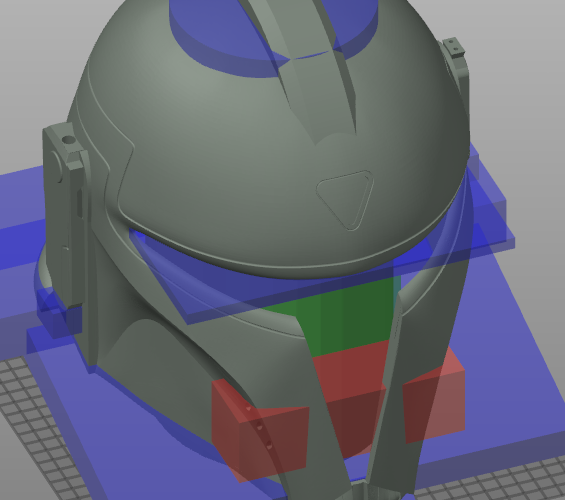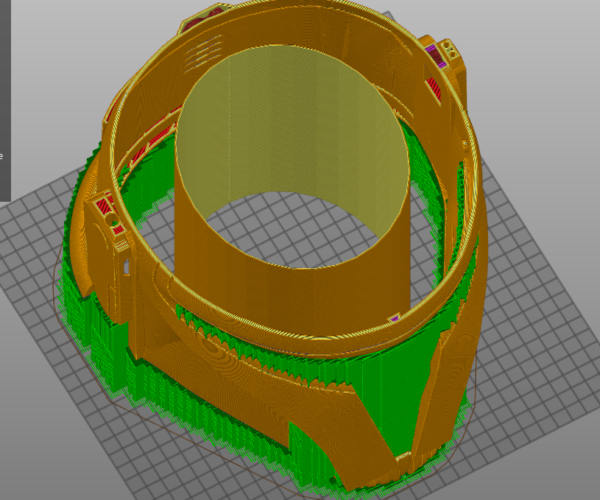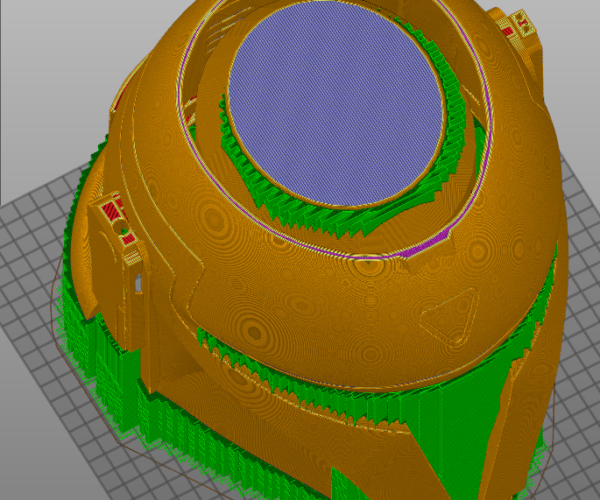Bridges in Support Planning / Design
I was wondering if there is anyway to incorporate bridging into the planning / design of support material. Basically, where appropriate, avoid creating a massive block of support material and instead create an outer border of support material (or two edges), bridge those supports at some point, then build more support material on top of the bridge. If this is not a feature it seems like the existing parameters for building the model with bridges could maybe be incorporated into the design / planning of support material.
I am printing a dome (actually top portion of Mandalorian helmet) and I was trying to minimize supports. I kind of "tricked" the software into building a bridge in middle of support structure by creating a throw-away part (a big plate with cutout below). Saves almost 4 hours and 23 meters of filament in this case (and this is far from optimized).
Sorry if this was discussed before (I could not find anything and don't spend much time in these forums).
RE: Bridges in Support Planning / Design
The software doesnt do that at the moment. Its easy enough to do manually though, basically the way you describe. I know from personal experience as I did it on a customised mandalorian helmet printed as one piece on my cr10.
I just modelled in a cylinder with a bevelled top and the top of it bridged , around 120mm bridging (my cr10 has much upgraded cooling). Then I used a support enforcer placed to intersect the middle top of the helmet above the support cylinder. That way only the section between has support on it. The cylinder has to be part of the same object for it to work though. 60 hour print, using a 2.3kg spool as I didn't want it running out during the night. Saved a LOT of filament and time. I should have modelled in support structures for the visor at the front too but I wasn't as familiar with Blender at the time.
RE: Bridges in Support Planning / Design
@neophyl
Thanks -- glad I was not missing something I guess. I did also try the tree supports in Cura but they were a bit of a mess so did not try printing with them yet.
FWIW -- I originally modeled a solid full-height semi-cylinder (hollowed out w/ 1.2mm sides) and then decided to test a small 1mm semi-cylinder at the top (with a .5mm top and .5mm hollow out w/ 1.2mm sides) -- my recollection is that solid sides use more filament than support fill. For some reason PrusaSlicer put supports throughout. So next I tried to put a 1mm hollow semi-cylinder at the bottom along with the 1mm semi-cylinder with solid top at the top. In this case it just put supports around the outside edge and [seemed to] use less filament than the solid sided shape. See picture below if you can see what I am talking about. Your mileage may vary since this was just a quick one-off test.
RE: Bridges in Support Planning / Design
@neophyl
By the way - your helmet looks great, wish I had a big enough build area to do it in one shot!
RE: Bridges in Support Planning / Design
The thing with Prusa slicer is that if you place separate objects on the plater it slices them individually. This is what allows the variable layer heights for different objects to work. It does have the downside that if you place 2 objects intersecting each other then it will slice and where they intersect you will get 2 x the plastic leading to bad things happening. So when you put another object in the same area as support for the first object the support is generated as if the second object isn’t there and goes right through it.
The ‘trick’ is to load the first object and then right click it and load part, then choose the second, in my case the support cylinder I’d also modelled for the helmet. This adds them to the plater as one model but with multiple parts. You can see that the right hand panel will show them in a tree structure. This will make the support go on top of the second object. You can then select the second object and change it’s slicing characteristics with a modifier. I just used no bottom layers, 2 perimeters and iirc about 4 top layers with zero infill for the cylinder. That way it’s hollow and I didnt have to model it that way, it’s just a primitive shape.
The build size was the only reason I bought a cr10s after I got my mk3, purely for printing a helmet. It’s just large enough to do a mando helmet but a 400x400 would have been better lol. Quality isn’t a patch on the mk3 though. I have it fitted with a .6 nozzle which is why the helmet only took 60 hours lol. Still a lot of sanding to do.
RE: Bridges in Support Planning / Design
@neophyl
Thanks -- Obviously I have so much more to learn about slicing software.
I still hope someone sees this thread and considers incorporating the bridging parameters into the support planning / structure aspects of PrusaSlicer. If this was done automatically by the software we could have far greater efficiency for supports.
I actually think that tree-style supports should be very effective for a dome like this but I was really disappointed at the way the Tree-style supports seemed to be working in Cura - it just looked like a chaotic mess and did not seem to be saving much support material since the trunk was so thick. I would have expected something far more symmetrical and organized given the simplicity and symmetry of the dome that needed support.
As I think through this I am really unsure if a narrow trunk with expanding branches or a wide but hollow trunk with vertical "branches" (which bridging basically could creates) is more efficient in terms of material and time.
RE: Bridges in Support Planning / Design
So finally had a chance to actually print the model that I posted about. Bridging inside supports works fine as you would expect. I was a bit worried about that outside long support wall that was distorting like crazy but never got so bad that things were stringing and now that the bridge / full top surface is in there should be no problem. This is actually the second part I did this way -- printed the smaller portion of the helmet this way as well and forcing even on a smaller print using a bridge surface inside supports still saves 30 or 40 minutes (in this print it saves 4 hours).
As discussed, I could have printed a solid thin shell semi-cylinder but it uses less filament to print supports over the same area.
https://photos.app.goo.gl/6gWXN1eWMRD1BzSH6
https://photos.app.goo.gl/1f8KAGK11V2HmUEV6




